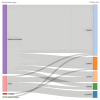Epidemiological Analysis of the COVID-19 Clusters in the Early Stages of the Epidemic in Shanghai, China: Pandemic-to-Epidemic Response Shift
- PMID: 40559737
- PMCID: PMC12197515
- DOI: 10.3390/tropicalmed10060170
Epidemiological Analysis of the COVID-19 Clusters in the Early Stages of the Epidemic in Shanghai, China: Pandemic-to-Epidemic Response Shift
Abstract
As COVID-19 transitions from pandemic to endemic, our prevention and control policies have shifted from broad, strict community interventions to focusing on the prevention of cluster outbreaks. Currently, information on the characteristics of cluster outbreaks remains limited. This study describes the features of COVID-19 clusters in Shanghai. It aims to provide valuable insights for managing localized outbreaks. We conducted a retrospective analysis of clusters of confirmed COVID-19 cases. Epidemiological descriptions, the transmission characteristics of clusters, and individual risk factors for contagiousness were analyzed. A total of 381 cases of COVID-19 were confirmed and 67 clusters were identified. Most clusters (58.21%, 39/67) only had two cases, with a declining proportion held by clusters of more cases. Familial transmission was predominant, accounting for 79.10% (53/67) of clusters. Although other types of cluster outbreaks, such as those in workplaces (1.49%, 1/67), occur less frequently compared to household clusters, they tend to involve larger scales and more cases. Workplaces and similar venues are more likely to experience large-scale cluster outbreaks. Contagiousness was higher among cases with runny nose (risk ratio [RR]: 4.8, 95% CI: 1.40-16.44, p-value = 0.01) and those with diabetes (RR: 3.8, 95% CI: 1.01-14.60, p-value = 0.05). In conclusion, household cluster outbreaks, in particular, are both a key priority and a foundational issue. Establishing an indicator system based on the transmissibility of cases holds significant practical value for infectious disease prevention and control. By enhancing household hygiene and developing a case classification and management system based on transmissibility, it is possible to better prevent and control regional COVID-19 outbreaks.
Keywords: COVID-19; clusters; epidemiology; outbreak; transmission.
Conflict of interest statement
The authors declare no conflicts of interest.
Figures



Similar articles
-
Signs and symptoms to determine if a patient presenting in primary care or hospital outpatient settings has COVID-19.Cochrane Database Syst Rev. 2022 May 20;5(5):CD013665. doi: 10.1002/14651858.CD013665.pub3. Cochrane Database Syst Rev. 2022. PMID: 35593186 Free PMC article.
-
Measures implemented in the school setting to contain the COVID-19 pandemic.Cochrane Database Syst Rev. 2022 Jan 17;1(1):CD015029. doi: 10.1002/14651858.CD015029. Cochrane Database Syst Rev. 2022. Update in: Cochrane Database Syst Rev. 2024 May 2;5:CD015029. doi: 10.1002/14651858.CD015029.pub2. PMID: 35037252 Free PMC article. Updated.
-
Sertindole for schizophrenia.Cochrane Database Syst Rev. 2005 Jul 20;2005(3):CD001715. doi: 10.1002/14651858.CD001715.pub2. Cochrane Database Syst Rev. 2005. PMID: 16034864 Free PMC article.
-
Workplace interventions to reduce the risk of SARS-CoV-2 infection outside of healthcare settings.Cochrane Database Syst Rev. 2022 May 6;5(5):CD015112. doi: 10.1002/14651858.CD015112.pub2. Cochrane Database Syst Rev. 2022. Update in: Cochrane Database Syst Rev. 2024 Apr 10;4:CD015112. doi: 10.1002/14651858.CD015112.pub3. PMID: 35514111 Free PMC article. Updated.
-
Systemic pharmacological treatments for chronic plaque psoriasis: a network meta-analysis.Cochrane Database Syst Rev. 2021 Apr 19;4(4):CD011535. doi: 10.1002/14651858.CD011535.pub4. Cochrane Database Syst Rev. 2021. Update in: Cochrane Database Syst Rev. 2022 May 23;5:CD011535. doi: 10.1002/14651858.CD011535.pub5. PMID: 33871055 Free PMC article. Updated.
References
LinkOut - more resources
Full Text Sources
Research Materials

